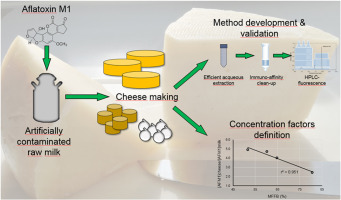Aflatoxins (AF) AFB1, AFB2, AFG1 and AFG2 are mycotoxins produced primarily by toxigenic strains of the fungi Aspergillus flavus and Aspergillus parasiticus, most typically found in areas characterized by hot, arid climates, and drought conditions (Cotty & Jaime-Garcia, 2007; Rushing & Selim, 2019). Fungal contamination of feed and food commodities may occur both pre- and post-harvest. In contaminated feed and food, AFB1 is normally present at higher concentrations than the others (Schrenk et al., 2020). When fed feedstuff contaminated by AFB1, lactating animals excrete it into milk after hydroxylation, forming aflatoxin M1 (AFM1) (Zentai, Jóźwiak, Süth, & Farkas, 2023). AFM1 has been classified as a group 1 compound – carcinogenic to humans – by the International Agency for Research on Cancer (IARC, 2012; Ostry, Malir, Toman, & Grosse, 2017). Even though AFM1 carcinogenic potency is evaluated to be about 1 tenth that of AFB1 (Schrenk et al., 2020), AFM1 is considered a very toxic compound to be maintained under strict control to reduce the risk of exposure for consumers. European Commission fixed a maximum limit of 0.050 μg kg−1 for AFM1 in milk and a limit of 0.025 μg kg−1 in infant formulae and milk products for infants (Commission Regulation (EU) 2023/915). Article 3 states that where no specific EU maximum levels are set out for food which is dried, diluted, processed, the food business operator shall provide and justify processing factors for the dried, diluted, processed food. Consequently, AFM1 limits in cheese (or dairy products) should be established according to the processing factor provided by producers, when available. Indeed, it has been reported that AFM1 interacts with the casein fraction and can be consequently transferred into dairy products, in particular in cheese, after cheese-making process (Barbiroli et al., 2007; Brackett & Marth, 1982).
In the case of milk an official International Organization for Standardization method (ISO, 2007) is available, whereas for cheese, several quantification methods have been proposed by many research groups. AFM1 extraction from cheese is challenging and different pre-treatment protocols involving the use of organic solvents for extraction or fat removal prior to analysis have been published (Al-Mossawei, Al-Zubaidi, Hamza, & Abduljaleel, 2016; Cavaliere et al., 2006; Colak, Hampikyan, Ulusoy, & Ergun, 2006; Fernandes, Corrêa, Rosim, Kobashigawa, & Oliveira, 2012). Unlike ELISA, HPLC-fluorescence determination of AFM1 in cheese requires a purification step to remove possible interfering co-extracts and enrich AFM1 content for detection at sub-ppb levels. In recent years, aqueous mixtures are being increasingly used in AFM1 determination because of their compatibility with ELISA or subsequent purification steps (Anfossi et al., 2008; Iha, Barbosa, Favaro, & Trucksess, 2011; Wood et al., 2021; Škrbić, Antić, Živančev, 2015). In contrast with organic extracts, aqueous solutions can be directly loaded onto solid phase extraction or immuno-affinity columns without interfering with their binding capacity and offering the advantage to reduce the use of toxic and expensive solvents.
In the present study, we adapted, optimized and validated a rapid analytical method for the purification and accurate quantification of AFM1 by HPLC-fluorescence detection. This method allows the analysis of several cheese samples within a working day by combining an extraction using an aqueous solution of citrate salts with an immuno-affinity purification, avoiding the use of chlorinated organic solvents and defatting steps. The method performances were successfully verified by analyzing cheese samples from international proficiency testing schemes (Progetto Trieste).
As an additional objective of the study we applied the analytical method to evaluate the transfer of AFM1 from milk to four different famous kinds of Italian cheese (i.e. mozzarella, caciotta, taleggio, Asiago d’Allevo). Such types of cheese were chosen not only for representing typical and well known national products, but also for belonging to different categories according to the classification proposed by EU decision 97/80/CE (Commission Decision, 1996), which classifies different types of cheese also on the basis of the moisture content on a fat-free basis (MFFB). Cheese wheels were prepared starting from raw milk artificially contaminated by AFM1 at a concentration close to the maximum contamination limit of 0.050 μg kg−1. Contaminated milk was analyzed by ISO 14501:2007 (ISO, 2007) method, whereas cheese wheels were analyzed according to the herein proposed and validated method.
Experimental data on the presence of AFM1 collected for different types of cheese falling into four MFFB categories, allowed us to estimate concentration factors of AFM1 for each cheese-making process considered. Such data can be used to assess the potential correlation between MFFB value and AFM1 concentration factor in cheese.


Dining and Cooking